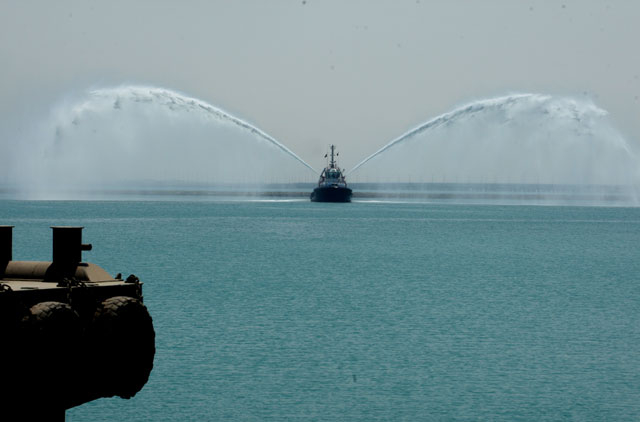
Abu Dhabi: Commercial activities started at Terminal One of Khalifa Port on Saturday, making it the first semi-automated port in the Mena region.
“The Dh26.5 billion project will act as an economic gateway of trade for Abu Dhabi, and has been completed before the required time while meeting the highest standards,” said Dr Sultan Ahmad Al Jaber, Chairman of the Abu Dhabi Ports Company (ADPC).
The Khalifa Port is an artificial island which stands five kilometres offshore adjacent to the Khalifa Industrial Zone Abu Dhabi.
Depite being in its first phase, the port’s terminal has a capacity of 2.5 million containers a year, with an additional 2.5 million which will be seen as it reaches its second phase (Terminal 2).
That capacity could be reached “in three to five years,” said Martijn Van De Linde, chief executive officer of Abu Dhabi Terminals, which operates Khalifa Port.
The size of the island hosting the offshore part of the port is 2.7 square kilometres, equivalent to 400 football pitches. Its total area, including onshore, is 9.1 square kilometres.
Both ADPC and DP World, the world’s third-largest port operator and owner of Jebel Ali, dismissed suggestions that they could end up competing for market share. ADPC maintains that Khalifa is a destination port, unlike Jebel Ali which focuses on transhipments to other ports.
Khalifa Port officially received its first ship, the 366-metre long MSC Bari, at 7am on Saturday. The ship, one of the largest and newest Post-Panamax container ships in the world, has a gross capacity of 14,000 containers and would not fit in Mina Zayed.
Big cargo to move from Mina Zayed to Khalifa Port
All containerised goods from Mina Zayed will be moved to the newly operational Khalifa Port within four to six months, Abu Dhabi Terminals (ADT) officials said.
“Everything except general goods such as steel, limestone, flour and vegetable oil will be trasferred to Khalifa Port as it is able to accommodate much larger ships than Mina Zayed. We hope to service 15 container ships a week as demand increases,” Martijn Van De Linde, CEO of Abu Dhabi Terminals, said.
Noting that the export-import ratio at Mina Zayed was about 80:20, he said Khalifa’s growth would be driven by exports.
“Industries based here are now starting to produce and export to China, Europe, Mediterranean and other regions. So our growth is being driven by exports and we have healthy imports as well.”
The cost of transportation of goods, and the flow of truck traffic in the city is expected to decrease as ships will now able to sail directly to the UAE. “Emirates Aluminium (EMAL) will no longer have to use Dubai’s Jebel Ali port to export goods but will instead use the Khalifa Port to do so,” Tony Douglas, CEO of Abu Dhabi Ports Company (ADPC) said.
The presence of the Khalifa Industrial Zone Abu Dhabi plays a major role in steering the UAE economy in the direction of the 2030 vision. The Industrial Zone will liven up production which, with the aid of the Khalifa port, will be exported globally.
According to project officials, even after movement travels from Mina Zayed, only 60 per cent of Khalifa Port’s terminal 1 capacity will be utilised, according to project officials. However, while Mina Zayed acted as a destination port where 90 per cent of arriving goods stayed within the UAE, Khalifa Port was designed to become an international hub of global trade.
“Working on this project not only meant dealing with complicated infrastructure and engineering, but also being environmentally sensitive of the Gulf’s only coral reefs living in Ras Ghanada,” said David Welch, President of Bechtel Corporation for construction and development. “The region itself it seeing a growth in infrastructural projects and we have had a pleasant experience working in the UAE for 50 years,” Welch added.
Abu Dhabi Ports Co (ADPC) said Khalifa Port, built on a man-made island in the Taweelah area, and its adjacent Khalifa Industrial Zone would together be two-thirds the size of Singapore when fully built.
— with inputs from agencies













